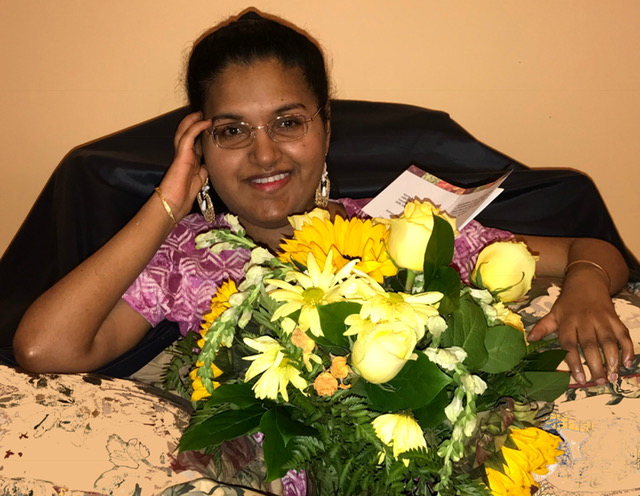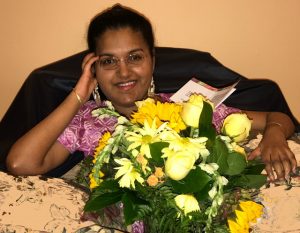Doctoral Student Invents Tools to Help Herself and Others with Disabilities
Written by |

Kavita Krishnaswamy, soon to earn her doctoral degree, develops devices to help others also living with SMA. (Photo courtesy of Kavita Krishnaswamy)
Kavita Krishnaswamy is so determined to gain independence for herself and others living with physical disabilities that she spends up to 20 hours a day designing devices.
“After I get ready for caregivers and have something to eat, I start working, working, working,” she said in an interview with SMA News Today. “I rest for awhile, then work again. I don’t sleep much. I always have new ideas.”
When she’s not busy inventing, Krishnaswamy is doing research or taking classes. She’s set to receive a doctorate degree in computer science next year from the University of Maryland, Baltimore County, or UMBC.
She’s doing all this with an upbeat disposition despite being in the advanced stages of spinal muscular atrophy. The progressive, debilitating disease affects the motor nerve cells in the spinal cord, causing incapacitating weakness and lack of muscle control. SMA affects about one in 11,000 babies, and roughly one in every 50 U.S. residents is a genetic carrier, according to CureSMA.
Krishnaswamy, 35, has the type 2 form of SMA, which manifests itself after a child learns to sit up. She has never stood or walked, and gets round-the-clock care.
Few treatment options are available for SMA, although a spate of clinical trials are under way. Biogen’s Spinraza, which is able to modify SMA, became the first U.S.-approved therapy for children and adults in December of 2016.
“God willing, I am waiting to start Spinraza soon,” said Krishnaswamy, who lives with her parents. “Even though safety is important, I just wish that the process of a medication going through trials becomes faster so that patients can be treated as soon as possible.”
Not that she’s waiting around. Krishnaswamy’s research at UMBC focuses on developing robotic system prototypes that can assist patients with moving from place to place, repositioning themselves, and personal care. So far she has completed 10 designs, ranging from a gripper that will gently wrap around a limb or the body to perform movement, to a robotic toothbrush. She’s working on acquiring patents.
Krishnaswamy is most effusive about her voice-controlled, inflatable, contoured mattress. It has several chambers filled with air pockets that can be pressurized to adjust height levels, minimizing the risk of bedsores. She hopes to build a full-scale model for demonstrations and feedback. She already holds a provisional patent on the mattress.
“There will be physiological data connected to the bed as well,” she said. “Algorithms can suggest to the user that it’s time to reposition, according to patterns that the algorithms put out over time.”
Most assistive robots have required at least middling patient strength to operate. Krishnaswamy is designing more accessible devices that use computer trackballs, verbal commands, or facial expressions.
She has also created an online survey on attitudes toward robotic aids and prospects for enhancing the quality of life of people with physical disabilities and their caregivers. The survey results will help her advance efforts to design prototypes of assistive robotics devices, which she hopes to develop commercially.
“My goal is to develop a robotic system so that I can use it to remotely help others,” Krishnaswamy said. “I want to be the one helping, instead of the one receiving help.”
Although there is increased focus on designing robots to assist those with physical disabilities, many devices these days were initially designed for other purposes, said Dr. Michael Wolfson, program director of the National Institute of Biomedical Imaging and Bioengineering. The agency is part of the National Institutes of Health.
“People in academia realized that they can repurpose what already exists for other uses, particularly healthcare,” he said in an interview. “This is in combination with a lot of research money going toward machine-learning advances, such as what we see with self-driving cars.”
Much of the early push for healthcare applications came from the Department of Defense after the United States sent troops to Iraq and Afghanistan. “Lots of individuals were coming back alive because of body armor but without limbs,” Wolfson said. “That inspired a whole field of research.”
Krishnaswamy is all in. A recipient of Ford and National Science Foundation fellowships, she recently won a Microsoft PhD Fellowship and a Google Lime Scholarship. For her doctoral project, she and Maya Cakmak, a computer science professor at the University of Washington, are developing interfaces that control a multi-functional robot to help those with disabilities reposition themselves and engage in other activities.
“For someone with a severe physical disability, and with no caregiver nearby, this can be used independently,” Krishnaswamy said. “Even if they can’t use their hands, they can use their voice.”
For all her accomplishments, Krishnaswamy is quick to credit others, including mentors and collaborators like her college adviser, Tim Oates. She reserves special praise for her parents. Her father, who has a doctorate in physics, has pushed her to be her best despite her paralysis — save for some muscles in her right hand — from the neck down. Her mother, who has a degree in economics, is a constant source of help, and even critiques her daughter’s designs.
“When I was growing up, due to my health conditions I didn’t think I would graduate even high school because I didn’t have anyone to assist me,” said Krishnaswamy, who was born in the Indian state of Tamil Nadu and moved with her family to the U.S. in 1982. “I’m very thankful my mother sacrificed her time by coming with me to all my classes, and made sure I had what I needed. I want to do the same for others.”
When she was in high school in Columbia, Maryland, Krishnaswamy participated in a statewide robotics competition. A member of the school’s Math, Engineering and Science Achievements Club, she designed a robot digitally. Because she couldn’t build it herself, her two younger brothers created it to her specifications. She won third place in the competition.
In college, Krishnaswamy worried that her disability would prevent her from achieving. Thanks to a professor’s suggestion, she began attending classes via Skype. That made the difference. “I’m very fortunate that most professors are very accommodating,” she said, adding that she hopes her experience encourages others with neuromuscular disorders.
She also relies on a Beam, a two-way-telecasting rolling robot she uses for academia and business, and operates from miles away. When she needs a break from her busy schedule, she uses the Beam to explore artwork at museums participating in the electronic access program.
It’s clear that Krishnaswamy is in a race to improve the quality of her life and that of others.
“I feel like this is my calling,” she said. “I feel I have to do my best to share my ideas, and learning from others is the best thing I can do to make an effective contribution in the field.”








